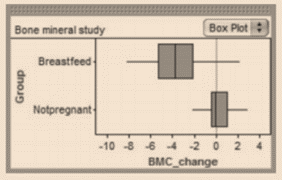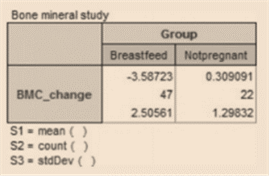
Concept explainers
(a)
To Write: a few lines on the basis of provided information comparing the percent variations in BMC for the two classes.
(a)
Explanation of Solution
Given:


The Not Pregnant Centre tends to be greater than the Breastfeeding Centre, since There is a higher mean for nonpregnant, and the boxplot much more to the right. The distribution appears to be more than the distribution for the Breastfeed community Non-pregnant party, since it has a higher standard deviation and there is more distance between the boxplot whiskers. Both distributions seem to be right-skewed, as the median to be the box of the boxplot further to the left.
(b)
To explain: for mothers who are breast-feeding, the mean change in BMC is significantly lower and an adequate test is conducted to confirm the response.
(b)
Answer to Problem 52E
Yes
Explanation of Solution
Given:
Formula used:
Calculation:
The hypothesis:
The test statistic:
The test statistic:
P-value in the row
There is ample evidence to support the argument that, for mothers who are breast-feeding, the mean change in BMC is substantially lower.
(c)
To explain: it may mean that breast-feeding causes weakening of the bones of a woman, why or why not.
(c)
Answer to Problem 52E
No
Explanation of Solution
In order to observe their reactions, an experiment purposefully imposes certain care on individuals. Without disrupting the scene, they are studying, an observational study tries to gather details. Observation Study Because the study is not an experiment,
(d)
To Construct: and interpreting a 95 percent confidence interval for the difference in mean bone mineral loss and explaining how more information is given by this interval than in part (b) the significance test.
(d)
Answer to Problem 52E
(-4.850, -2.943)
Explanation of Solution
Given:
Formula used:
For the confidence interval
Calculation:
Degrees of freedom is
Determine
Confidence interval are for
95 percent are confident that the mean distance is between -4.850 and -2.943.
Chapter 10 Solutions
The Practice of Statistics for AP - 4th Edition
Additional Math Textbook Solutions
Essentials of Statistics (6th Edition)
Elementary Statistics: Picturing the World (6th Edition)
STATS:DATA+MODELS-W/DVD
Introductory Statistics
An Introduction to Mathematical Statistics and Its Applications (6th Edition)
Introductory Statistics (2nd Edition)
 MATLAB: An Introduction with ApplicationsStatisticsISBN:9781119256830Author:Amos GilatPublisher:John Wiley & Sons Inc
MATLAB: An Introduction with ApplicationsStatisticsISBN:9781119256830Author:Amos GilatPublisher:John Wiley & Sons Inc Probability and Statistics for Engineering and th...StatisticsISBN:9781305251809Author:Jay L. DevorePublisher:Cengage Learning
Probability and Statistics for Engineering and th...StatisticsISBN:9781305251809Author:Jay L. DevorePublisher:Cengage Learning Statistics for The Behavioral Sciences (MindTap C...StatisticsISBN:9781305504912Author:Frederick J Gravetter, Larry B. WallnauPublisher:Cengage Learning
Statistics for The Behavioral Sciences (MindTap C...StatisticsISBN:9781305504912Author:Frederick J Gravetter, Larry B. WallnauPublisher:Cengage Learning Elementary Statistics: Picturing the World (7th E...StatisticsISBN:9780134683416Author:Ron Larson, Betsy FarberPublisher:PEARSON
Elementary Statistics: Picturing the World (7th E...StatisticsISBN:9780134683416Author:Ron Larson, Betsy FarberPublisher:PEARSON The Basic Practice of StatisticsStatisticsISBN:9781319042578Author:David S. Moore, William I. Notz, Michael A. FlignerPublisher:W. H. Freeman
The Basic Practice of StatisticsStatisticsISBN:9781319042578Author:David S. Moore, William I. Notz, Michael A. FlignerPublisher:W. H. Freeman Introduction to the Practice of StatisticsStatisticsISBN:9781319013387Author:David S. Moore, George P. McCabe, Bruce A. CraigPublisher:W. H. Freeman
Introduction to the Practice of StatisticsStatisticsISBN:9781319013387Author:David S. Moore, George P. McCabe, Bruce A. CraigPublisher:W. H. Freeman





